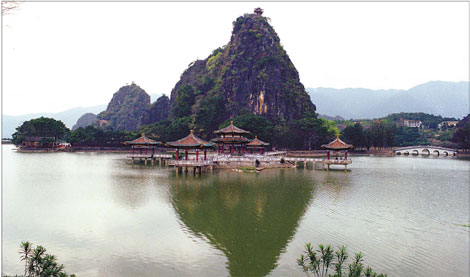Seven stars for Zhaoqing
|
|
|
Limestone rock formations, lakes and pavilions are a visual treat at Seven Stars Scenic Area in Zhaoqing. Bei Huan / For China Daily |
Think of Guangdong and 'Made in China' is likely to be the first thing that comes to mind, but there is more to the province than manufacturing, as Jules Quartly discovers
Guangdong is known around the world, but not for its greenery. It's home to Guangzhou and Shenzhen, and has earned its title as "the world's manufacturing base", making it China's most populous and prosperous province.
Zhaoqing, however, wants to position itself as "Guangdong's back garden" and its cause has merit.
It can boast of founding the country's first nature reserve in 1956, pristine Dinghu Mountain; the peerless Seven Stars Scenic Area; and a 500-km green route that includes water villages, a giant stone to rival Australia's Ayers Rock, and plenty more pleasant surprises.
At the heart of Zhaoqing is West River, which flows through the city before emptying into Zhujiang River and the South China Sea. Zhaoqing residents will repeatedly remind you that its volume of flow is second only to the Yangtze River.
Meanwhile, Dr Chen Jinluan of the Zhaoqing Environmental Protection Bureau, makes his case for a "green city" by saying it comprises 20 percent waterways, 67 percent forest and is 73 percent mountainous, with a minimum of 360 "clean air days" a year.
Thus briefed, we struck out for Dinghu Mountain, also known as the "green gem on the Tropic of Cancer", which gives an idea of the subtropical climate that creates a verdant home of over 2,400 species of plants, 38 kinds of animals and 178 types of birds, some of them under State protection, including the province's official mascot, the silver pheasant.
There are a number of trails to choose from, depending on fitness and time. Ours began near the summit, where there are a couple of striking aboriginal statues reminding visitors that the original inhabitants of this primitive forest were the Baiyue tribe. There is also the world's largest Longhuang inkstone; and what used to be the biggest "ding", the Nine-Dragon Cauldron, a tripod vessel representing power.
 0
0 









Go to Forum >>0 Comments